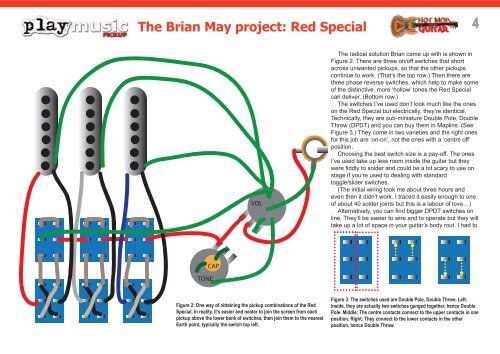The Brian May Project - Play Music Pickup
The Brian May Project - Play Music Pickup
The Brian May Project - Play Music Pickup
You also want an ePaper? Increase the reach of your titles
YUMPU automatically turns print PDFs into web optimized ePapers that Google loves.
<strong>The</strong> <strong>Brian</strong> <strong>May</strong> project: Red Special<br />
TONE<br />
CAP<br />
VOL<br />
Figure 2: One way of obtaining the pickup combinations of the Red<br />
Special. In reality, it’s easier and neater to join the screen from each<br />
pickup above the lower bank of switches, then join them to the nearest<br />
Earth point, typically the switch top left.<br />
<strong>The</strong> radical solution <strong>Brian</strong> came up with is shown in<br />
Figure 2. <strong>The</strong>re are three on/off switches that short<br />
across unwanted pickups, so that the other pickups<br />
continue to work. (That’s the top row.) <strong>The</strong>n there are<br />
three phase reverse switches, which help to make some<br />
of the distinctive, more ‘hollow’ tones the Red Special<br />
can deliver. (Bottom row.)<br />
<strong>The</strong> switches I’ve used don’t look much like the ones<br />
on the Red Special but electrically, they’re identical.<br />
Technically, they are sub-miniature Double Pole, Double<br />
Throw (DPDT) and you can buy them in Maplins. (See<br />
Figure 3.) <strong>The</strong>y come in two varieties and the right ones<br />
for this job are ‘on-on’, not the ones with a ‘centre off’<br />
position.<br />
Choosing the best switch size is a pay-off. <strong>The</strong> ones<br />
I’ve used take up less room inside the guitar but they<br />
were fiddly to solder and could be a bit scary to use on<br />
stage if you’re used to dealing with standard<br />
toggle/slider switches.<br />
(<strong>The</strong> initial wiring took me about three hours and<br />
even then it didn’t work. I traced it easily enough to one<br />
of about 40 solder joints but this is a labour of love…)<br />
Alternatively, you can find bigger DPDT switches on<br />
line. <strong>The</strong>y’ll be easier to wire and to operate but they will<br />
take up a lot of space in your guitar’s body rout. I had to<br />
Figure 3. <strong>The</strong> switches used are Double Pole, Double Throw. Left:<br />
Inside, they are actually two switches ganged together, hence Double<br />
Pole. Middle: <strong>The</strong> centre contacts connect to the upper contacts in one<br />
position. Right: <strong>The</strong>y connect to the lower contacts in the other<br />
position, hence Double Throw.<br />
4






